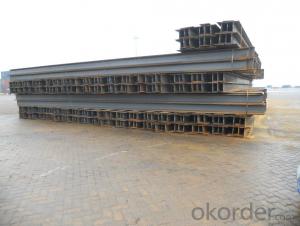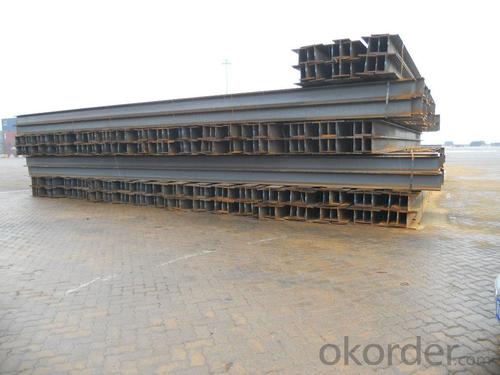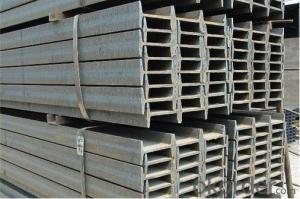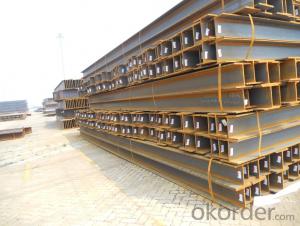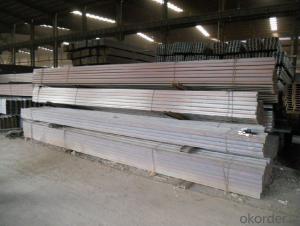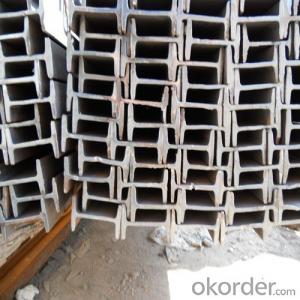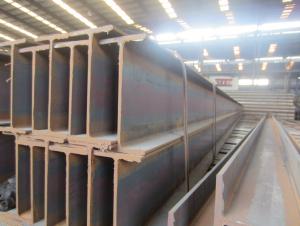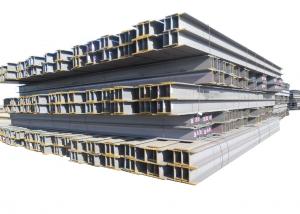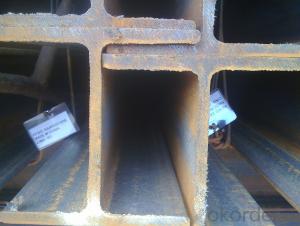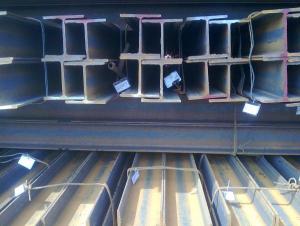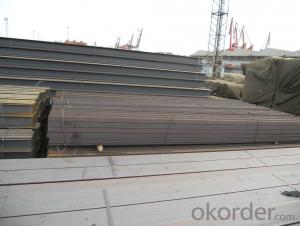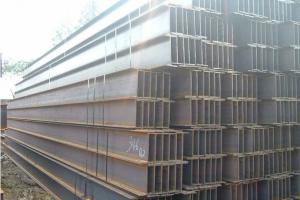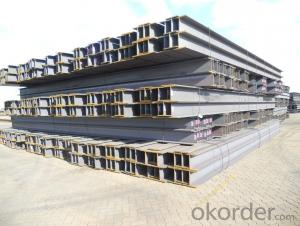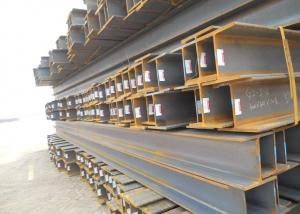Hot Rolled Steel H-Beam used for Prefabrication structure
- Loading Port:
- Tianjin
- Payment Terms:
- TT OR LC
- Min Order Qty:
- 10000 m.t.
- Supply Capability:
- 100000 m.t./month
OKorder Service Pledge
OKorder Financial Service
You Might Also Like
Specification
Product Description:
Product Description:
OKorder is offering Hot Rolled Steel H-Beam used for Prefabrication structure at great prices with worldwide shipping. Our supplier is a world-class manufacturer of steel, with our products utilized the world over. OKorder annually supplies products to European, North American and Asian markets. We provide quotations within 24 hours of receiving an inquiry and guarantee competitive prices.
Product Applications:
Hot Rolled Steel H-Beam used for Prefabrication structure are ideal for structural applications and are widely used in the construction of buildings and bridges, and the manufacturing, petrochemical, and transportation industries.
Product Advantages:
OKorder's Hot Rolled Steel H-Beam used for Prefabrication structure are durable, strong, and resist corrosion.
Main Product Features:
· Premium quality
· Prompt delivery & seaworthy packing (30 days after receiving deposit)
· Corrosion resistance
· Can be recycled and reused
· Mill test certification
· Professional Service
Product Specifications:
Specifications of Hot Rolled Steel H-Beam for Prefabrication structure
1. Standard: GB700-88, Q235B2.
2. Grade: Q235, SS400 or Equivalent
3. Length:10m, 12m as following table
4. Invoicing on theoretical weight or actual weight as customer request
5.Payment: TT or L/C
6. Sizes:
SIZE(mm) | DIMENSION(kg/m) |
150*150 | 31.1 |
148*100 | 20.7 |
198*99 | 17.8 |
200*100 | 20.9 |
248*124 | 25.1 |
250*125 | 29 |
Usage & Applications of Hot Rolled Steel H-Beam used for Structure Steel
Commercial building structure ;Pre-engineered buildings; Machinery support structure; Prefabricated structure; Medium scale bridges; Ship-building structure. etc.
Packaging & Delivery of Hot Rolled Steel H-Beam used for Prefabrication structure
1. Packing: it is nude packed in bundles by steel wire rod
2. Bundle weight: not more than 3.5MT for bulk vessel; less than 3 MT for container load
3. Marks:
Color marking: There will be color marking on both end of the bundle for the cargo delivered by bulk vessel. That makes it easily to distinguish at the destination port.
Tag mark: there will be tag mark tied up on the bundles. The information usually including supplier logo and name, product name, made in China, shipping marks and other information request by the customer.
If loading by container the marking is not needed, but we will prepare it as customer request.
4. Transportation: the goods are delivered by truck from mill to loading port, the maximum quantity can be loaded is around 40MTs by each truck. If the order quantity cannot reach the full truck loaded, the transportation cost per ton will be little higher than full load.
5. Delivered by container or bulk vessel
Production flow of Hot Rolled Steel H-Beam used for Prefabrication structure
Material prepare (billet) —heat up—rough rolling—precision rolling—cooling—packing—storage and transportation
FAQ:
Q1: Why buy Materials & Equipment from OKorder.com?
A1: All products offered byOKorder.com are carefully selected from China's most reliable manufacturing enterprises. Through its ISO certifications, OKorder.com adheres to the highest standards and a commitment to supply chain safety and customer satisfaction.
Q2: How do we guarantee the quality of our products?
A2: We have established an advanced quality management system which conducts strict quality tests at every step, from raw materials to the final product. At the same time, we provide extensive follow-up service assurances as required.
Images:
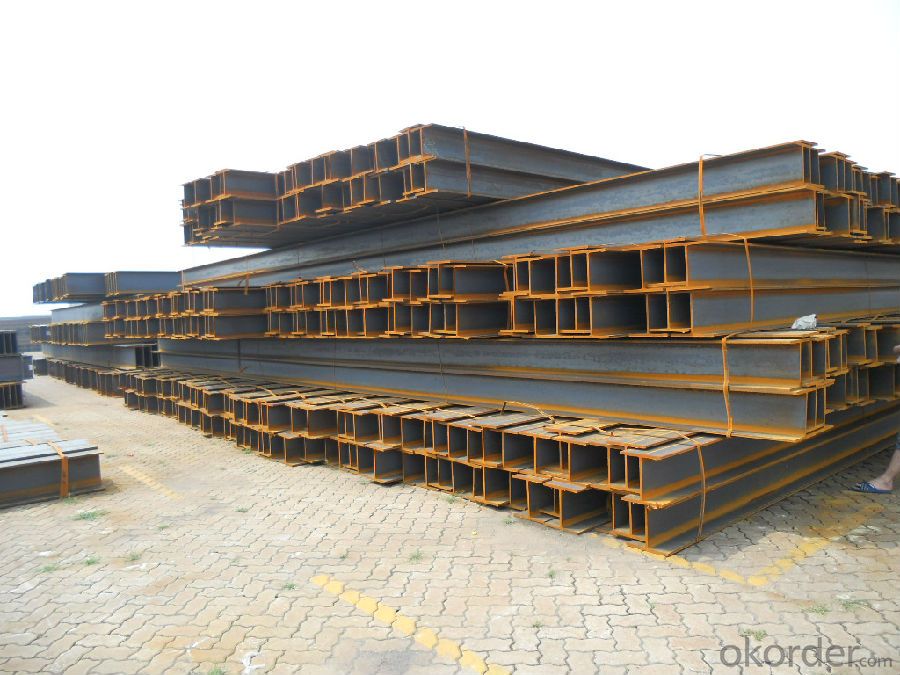
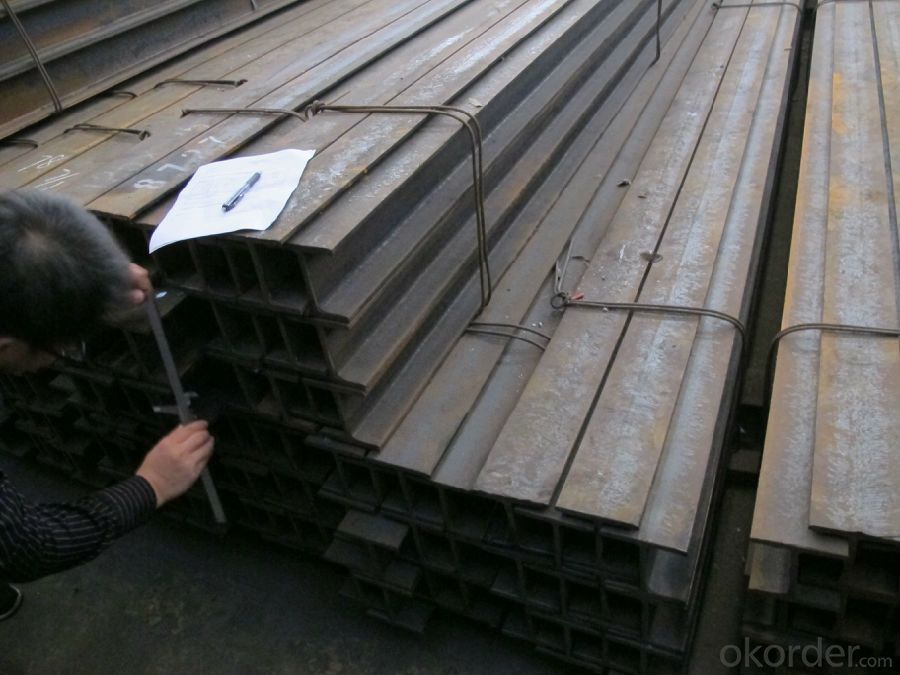
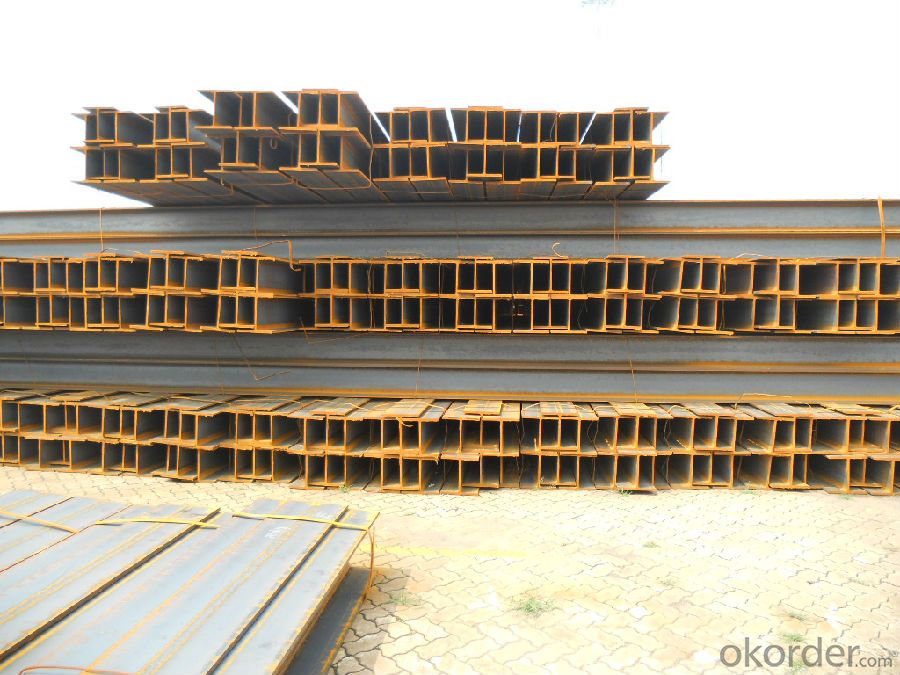
- Q: Are steel H-beams resistant to chemical exposure or spills?
- Steel H-beams are generally resistant to chemical exposure or spills. Steel is known for its durability and strength, making it less susceptible to damage from chemical substances. However, the specific level of resistance depends on the type and concentration of the chemical involved. While steel is generally resistant to most chemicals, highly corrosive substances or prolonged exposure to certain chemicals may eventually cause deterioration and compromise the structural integrity of the H-beams. Therefore, it is essential to consider the specific chemical environment and consult with experts or manufacturers to ensure the appropriate grade of steel is chosen for the intended application. Additionally, proper maintenance and regular inspections are crucial to identify any signs of corrosion or damage caused by chemical exposure and take appropriate measures to mitigate potential risks.
- Q: Can steel H-beams be used for agricultural buildings?
- Yes, steel H-beams can be used for agricultural buildings. Steel H-beams are commonly used in construction due to their strength, durability, and cost-effectiveness. They provide structural support and can withstand various weather conditions, making them suitable for agricultural buildings such as barns, storage facilities, or equipment sheds.
- Q: How do steel H-beams contribute to the overall architectural design of a building?
- Steel H-beams are a crucial component in the overall architectural design of a building as they provide several key contributions. Firstly, H-beams offer exceptional strength and load-bearing capacity, allowing architects to design structures with larger spans and higher vertical loads. This structural integrity is vital in ensuring the safety and stability of the building. Moreover, H-beams allow for flexible and versatile design options. Their shape allows for easy connection and integration with other building materials, enabling architects to create unique and innovative designs. Whether it is for constructing large open spaces, cantilevered structures, or intricate roof designs, steel H-beams provide the necessary stability and support. Furthermore, H-beams offer a cost-effective solution for architectural design. Steel is a highly durable and long-lasting material, requiring minimal maintenance and repair over its lifespan. Additionally, steel H-beams are prefabricated, allowing for efficient construction processes and reducing labor costs. In terms of aesthetics, steel H-beams can also enhance the visual appeal of a building. Their sleek and modern appearance can be incorporated as an architectural feature, creating an industrial or contemporary look. Additionally, H-beams can be left exposed, revealing the structural elements and adding a sense of uniqueness to the building's design. Overall, steel H-beams contribute significantly to the architectural design of a building by providing strength, flexibility, cost-effectiveness, and aesthetic appeal. Their structural capabilities allow architects to realize their creative visions while ensuring the safety and durability of the structure.
- Q: How do steel H-beams compare to wooden beams in terms of strength?
- Steel H-beams are significantly stronger than wooden beams when comparing their strength. Steel is known for its exceptional strength and durability, making it a popular choice for structural components such as H-beams. These beams are specifically designed to provide maximum strength and support, making them ideal for large-scale construction projects and heavy-load applications. Wooden beams, on the other hand, have limitations in terms of strength compared to steel. While wood can be a suitable option for smaller, less demanding structures, it may not have the same load-bearing capacity as steel. Wood is prone to warping, splitting, and decay over time, which can compromise its overall strength and structural integrity. Steel H-beams, being made of a much stronger material, can withstand higher loads and offer better resistance to bending, twisting, and shearing forces. This enhanced strength allows them to support larger spans and heavier loads, making them a preferred choice in high-rise buildings, bridges, and industrial structures. Additionally, steel H-beams have a higher strength-to-weight ratio compared to wooden beams. This means that they can provide greater strength while using less material, resulting in lighter and more cost-effective structures. Moreover, steel is not susceptible to termite damage, rot, or other environmental factors that can degrade wooden beams over time, ensuring long-term durability. In conclusion, steel H-beams outperform wooden beams in terms of strength due to their inherent characteristics. They offer superior load-bearing capacity, increased resistance to various forces, and better durability, making them the preferred choice for heavy-duty construction projects.
- Q: Can steel H-beams be used in the construction of residential towers or skyscrapers?
- Yes, steel H-beams can be and are commonly used in the construction of residential towers and skyscrapers. These beams provide structural support and are known for their strength, durability, and ability to withstand heavy loads.
- Q: How do steel H-beams connect to other structural elements?
- Steel H-beams can connect to other structural elements in a variety of ways depending on the specific design and engineering requirements of the project. One common method is through the use of bolts or welds. When connecting to other steel components, such as columns or beams, H-beams are often bolted together using high-strength bolts. These bolts are inserted through pre-drilled holes in the flanges (horizontal top and bottom sections) of the H-beam and then tightened with nuts. This creates a secure and rigid connection between the H-beam and the other structural elements. Welding is another method used to connect steel H-beams to other structural elements. In this case, the flanges of the H-beam are welded to the adjacent components, ensuring a strong and permanent connection. Welding is often preferred in situations where high load-bearing capacity and structural integrity are crucial. In addition to bolts and welds, other connection methods such as connectors or brackets can also be used depending on the specific requirements of the project. These connectors or brackets are often designed to provide additional strength and stability to the connection between the H-beam and other structural elements. It is important to note that the connection method used for steel H-beams depends on various factors, including the load-bearing capacity, structural design, and safety regulations. These factors are carefully considered by structural engineers and designers to ensure that the connection is strong, secure, and able to withstand the forces and loads imposed on the structure.
- Q: Can steel H-beams be used in mezzanine floors?
- Yes, steel H-beams can be used in mezzanine floors. They are commonly used as structural supports due to their high strength and load-bearing capacity, making them an ideal choice for creating additional floor space in buildings.
- Q: What is the purpose of using steel H-beams in construction?
- The purpose of using steel H-beams in construction is to provide structural support and stability. These beams have a distinctive "H" shape, which allows them to distribute the weight of the building evenly and efficiently. Steel H-beams are known for their high strength-to-weight ratio, making them an ideal choice for constructing large structures that need to withstand heavy loads. They are commonly used in the construction of bridges, buildings, and other infrastructure projects. The H-shape design also provides flexibility in terms of connecting different sections, allowing for easy customization and adaptation to specific project requirements. Overall, steel H-beams are essential in construction as they offer durability, strength, and stability, ensuring the safety and longevity of the structures they support.
- Q: Are steel H-beams suitable for structures with architectural features?
- Yes, steel H-beams are suitable for structures with architectural features. Steel H-beams are widely used in construction due to their strength, versatility, and ability to support various architectural designs. They can be fabricated and shaped to create unique architectural features while providing structural support. Their durability and load-bearing capacity make them an ideal choice for creating aesthetically pleasing structures with intricate architectural details.
- Q: What are the thermal conductivity properties of steel H-beams?
- Steel H-beams exhibit a relatively high level of thermal conductivity. Thermal conductivity refers to a material's capacity to transfer heat. Compared to materials like wood or plastics, steel demonstrates superior thermal conductivity due to its ability to conduct heat effectively. The precise thermal conductivity of steel H-beams may differ depending on the specific alloy and composition of the steel utilized. Nevertheless, on average, steel exhibits a thermal conductivity range of 15 to 50 W/m·K (watts per meter kelvin). Consequently, steel H-beams excel in facilitating heat transfer and are capable of rapidly distributing thermal energy throughout their structure. The exceptional thermal conductivity of steel H-beams renders them suitable for diverse applications within the fields of construction and engineering. For instance, when employed in buildings, steel H-beams can aid in the dissipation of heat and the prevention of hot spots. Moreover, they can be utilized in heat transfer systems such as heat exchangers, where efficient heat transfer is paramount. In summary, steel H-beams possess commendable thermal conductivity properties, enabling them to conduct and distribute heat efficiently.
Send your message to us
Hot Rolled Steel H-Beam used for Prefabrication structure
- Loading Port:
- Tianjin
- Payment Terms:
- TT OR LC
- Min Order Qty:
- 10000 m.t.
- Supply Capability:
- 100000 m.t./month
OKorder Service Pledge
OKorder Financial Service
Similar products
Hot products
Hot Searches
Related keywords
